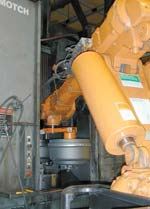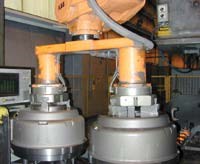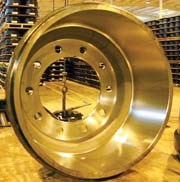Moving Parts, Moving Data, Keeping People
This Plant's labor-saving automation includes hardware for updating CNC offsets to adjust for gradual process changes. When the plant adopted its automated system, management thought carefully about the impact on staffing.
Think “automation,” and your first thought is likely to involve a robot. Webb Wheel’s Plant 4 in Cullman, Alabama, has one of these. It has two, in fact—one for each cell machining brake drums and rotors. These robots move parts.
However, each cell also includes another, equally vital labor-saving device that serves only to move data. When turned parts are inspected at an automated gaging station, the gage’s control unit compensates for the effects of tool wear and other process variables by sending corrections to the lathe’s CNC. Thus, in the same way that the robot automates loading and unloading, the gaging station automates the work of measuring, interpreting the measurement results, and inputting the appropriate offset changes.
This automated system brings new efficiency to long-serving machine tools. Drums and rotors are still machined on the same Motch vertical lathes and Natco drilling machines that used to be loaded by hand. The Natco machines, in fact, are about 40 years old. But now, two lathes and two drilling machines per cell are tied together within an automated process that includes a dual-gripper robot from ABB (New Berlin, Wisconsin) and a “Computer-Aided Gaging” unit from Edmunds Gages (Farmington, Connecticut). Because of the automation hardware, these machine tools now run with greater productivity, one half as much labor, and dramatically less error and scrap—all while cutting parts to better accuracy than it was ever practical for Webb to maintain before.
The system was designed by Factory Automation Systems of Atlanta, Georgia. Webb Wheel turned to this integrator not primarily to make better use of its machines, but instead to make better use of employees. Plant 4 focuses on brake systems for semi trucks, and the machined parts used in these assemblies are heavy. Base castings for drums can weigh 215 pounds apiece. Maneuvering these parts into the machine tools using overhead cranes was physically demanding work—so demanding that it tended to favor younger employees. A production operation critical to the company therefore had difficulty retaining experienced personnel.
And the frequent use of less-experienced employees at these machines made a common source of error more common still—inputting the wrong number when manually updating a CNC tool offset. Instead of adding a thousandth, for example, an operator might easily subtract a thousandth. Or instead of entering “0.012,” the operator might enter “0.021.” Manufacturing vice president Mike Canada set about searching for a solution to this source of error almost as soon as he began the investigation into robotic work handling. The company was determined to automate not just specific operator functions, but the complete machining process instead.
Turn, Gage, Drill
A vision system from Cognex (Natick, Massachusetts) now inspects the orientation of raw parts as they come off a roller conveyor. The robot takes the part from the conveyor to a lathe, from the lathe to a part washer, and from the part washer to the automated gaging station.
This station, supplied by Edmunds, uses two electronic bore gage heads to inspect a drum’s pilot bore and brake bore. The Computer-Aided Gaging unit—or “CAG” unit—interprets the results and initiates the appropriate response. If for some reason the part breaks tolerance, the robot carries it to an outfeed conveyor. If the part is instead acceptable, the robot carries it to a drilling machine for the rest of machining. If an acceptable part includes a bore measurement that departs from the bore’s nominal value, then the CAG unit sends an offset correction to the CNC that arrives in time to help not the next piece in line (which is already in the lathe), but instead the very next piece after that. The CAG unit also maintains a running history of the measurement data, generating real-time graphical displays that are available either at the CAG unit itself or at the cell’s operator control panel.
Two such cells, consisting of two lathes and two drilling machines apiece, machine all of the drums and rotors that pass through the Cullman plant. Most of the part variety results from the drums, which come in more than 60 different part numbers machined in a wide variety of batch sizes. Depending on customer requirements, a given drum design may be machined in a run of 7,000 pieces, but it may also be produced in a batch of just 70 pieces before the cell takes up yet another design. None of the machines is dedicated, meaning any lathe or drilling machine can be configured to run any drum or rotor part.
Each of these machine tools used to require its own operator. By contrast, one employee who attends to the part conveyors, implements part number changes, and oversees other functions related to managing the cell can now keep two machines running at full capacity. That in itself represents a considerable savings for the plant, with labor cost per part now cut in half.
However, that savings had obvious implications for the plant’s employees. The way in which Webb Wheel addressed its own reduced need for machining personnel offers a model that may be instructive to any shop contemplating a similar transition to an automated process.
No Layoffs
At the Cullman facility, there is a culture that seems to be more common among manufacturing facilities in the southern United States. The number of managers in the plant is sparse, in part because an attitude of mutual respect among employees breeds a climate of cooperation. Speech patterns even hint at this climate; a passerby who might be referred to as “that guy” in another part of the country is referred to as “that gentleman” in this part of Alabama. This conversational trait is a surface aspect of a deeper attitude that affects the way this plant is governed. Employees here are expected and encouraged to learn many different functions in the plant, shifting frequently from station to station as the day-to-day needs of the plant require. The ideal employee is simply ready to help out as needed. The flexibility that results from this culture made it much easier for Webb Wheel to make the commitment that it did before the automation was installed.
No employee would lose his job to a robot, said the company. Any employee doing good work before the automation was installed would still have a job afterward.
Making that announcement was one of the first steps the company took after deciding to purchase the automated system. There was a potential cost. The company was prepared to run with more employees than it needed until natural attrition could bring the employment level down. As it turned out, unanticipated departures during the 6-month installation period made it unnecessary for the company to pay that price.
But it did realize the benefit. The reason for the company’s commitment was its recognition of the potential value of employees’ energy and enthusiasm. A threatened workforce would make the successful implementation of the cells that much more difficult to achieve. But a workforce that stood to enjoy the benefits of the plant’s improvement alongside the rest of the company became a ready participant in the transition. Webb Wheel employees did much of the installation work for new cells themselves, not only saving some cost for the company, but also allowing the employees to develop a valuable knowledge base about how these cells function.
Both the installation and the implementation were successful enough that two more cells were installed at a nearby sister plant. The implementation was so successful, in fact, that safeguards the company put in place against glitches with either cell proved to be unnecessary. The company was careful to keep the rails in place for overhead cranes in case a robot failed, but in the 28 months the cells have been operational, those rails have never been used.
Cost And Quality
Plant manager Duane Ricketts, along with supervisors Brandon Blackwood and Mike Self, recently sat down to discuss the many advantages the plant has realized as a result of shifting to more automated machining. The benefits, they say, include all of the following:
- Labor cost savings. The number of labor hours involved in machining every part has been cut in half. This represents a significant cost savings.
- Safety. With robots now moving the heavy parts, the danger of back strain has been dramatically reduced. In addition, each cell has a control panel allowing much of the operator’s work to be performed outside the cell and well away from the machines. (Paperless part prints and work instructions are also available here.) As a result of these changes, the plant has seen the rate of recordable accidents drop by more than 50 percent.
- Improved productivity. Machining cycle times have not changed significantly, because the plant has spent some cycle time savings to improve its parts. (See below.) However, the automated cells do keep running through lunches and breaks. In Webb Wheel’s round-the-clock process, this change adds hours of productivity every day.
- Reduced scrap, reduced downtime and improved precision. All three of these benefits are directly attributable to the CAG unit and its ability to enter precise and reliable tool offsets directly into the lathe’s CNC. Errors in entering these offsets by hand used to be a frequent reason why parts were scrapped or reworked. Worse, these errors often led to machine downtime. An incorrect offset that sent the tool tip to the wrong position might not only scrap a part, but also produce a crash that damaged a chuck or a setup pin. Entering offsets automatically eliminates this source of error.
It also allows the machine tool to cut more precisely. Bore measurements used to be made by hand using a micrometer. This method not only made it impossible to check every part, but it also introduced variability into the measurement because of the differences in measurement technique from employee to employee. Relying on this method limited how quickly and how well the shop could respond to tool wear and other process changes, even when changes to the offset values were entered perfectly at the CNC.
Now the process is much different. The gaging station controlled by the CAG unit measures every part far more consistently than manual measurement would ever allow, and it updates the process in real time. The lathe can now be trusted to machine more accurately, because the impact of tool wear is no longer a source of such wide uncertainty.
Webb Wheel took advantage of both the improved precision and some cycle time savings in order to improve the quality of its parts. Brake drum bores now receive an additional machining pass that improves bore roundness, surface finish and dimensional consistency from part to part.
- Increased employee value. It used to be that an employee involved in machining at Webb Wheel would load parts into a single machine tool. Now, that employee oversees a complete machining process that involves multiple machines. The employee that used to be valued for the strength of his back is now valued for his alertness, skill, and experience—in other words, for the quality of his mind.
In terms of Webb Wheel’s ability to interest and retain valued personnel, this aspect of the shift to automation may be the most valuable change of all, says Mr. Ricketts. Instead of favoring younger and less experienced employees, machining is now a function that an employee can continue to perform with ever-increasing efficiency throughout all of his time with the company up until the day he retires.
Related Content
Choosing the Correct Gage Type for Groove Inspection
Grooves play a critical functional role for seal rings and retainer rings, so good gaging practices are a must.
Read MoreParts and Programs: Setup for Success
Tips for program and work setups that can simplify adjustments and troubleshooting.
Read MoreA Case for Combining Workholding with Optical Scanning
Automotive dies and die inserts are often complex, one-off parts with little room for error. Integrity Tool's investments in modular workholding tools and 3D optical scanning have allowed the company to create niche capabilities for its CNC machined parts.
Read MoreHow to Choose the Correct Measuring Tool for Any Application
There are many options to choose from when deciding on a dimensional measurement tool. Consider these application-based factors when selecting a measurement solution.
Read MoreRead Next
3 Mistakes That Cause CNC Programs to Fail
Despite enhancements to manufacturing technology, there are still issues today that can cause programs to fail. These failures can cause lost time, scrapped parts, damaged machines and even injured operators.
Read MoreThe Cut Scene: The Finer Details of Large-Format Machining
Small details and features can have an outsized impact on large parts, such as Barbco’s collapsible utility drill head.
Read More
.jpg;width=70;height=70;mode=crop)
















.png;maxWidth=300;quality=90)
















